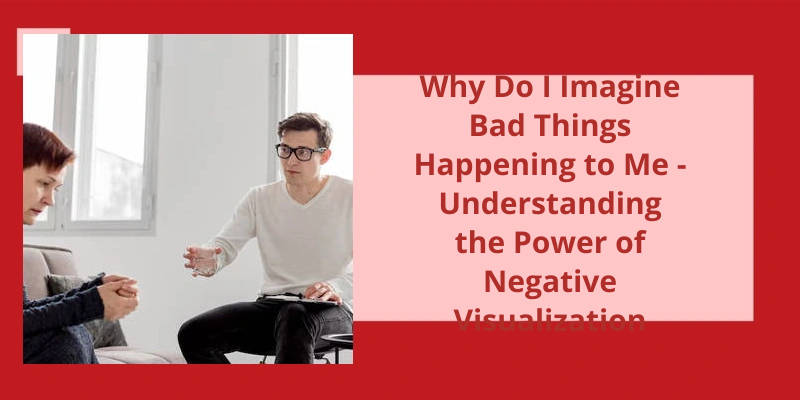"Why do I imagine bad things happening to me?" This is a question that many individuals ask themselves, as they grapple with the pervasive tendency to catastrophize. It’s a self-protective mechanism, aiming to shield us from harm, both physical and mental. After all, if we can anticipate and emotionally brace ourselves for the worst-case scenario, the thinking goes, we'll be better equipped to handle it when it inevitably arises. However, there lies a fundamental flaw in this logic: the assumption that our worst-case predictions are accurate and that they accurately reflect the impact these events would have on us. In truth, catastrophizing is only truly helpful if we possess the uncanny ability to predict the future with unwavering precision, and if we can accurately gauge the emotional toll each negative event would exact upon us. But alas, we’re fallible beings, prone to cognitive biases and distorted thinking patterns. Thus, our propensity to vividly imagine calamities often serves more to incite needless anxiety and distress than to safeguard our well-being. To understand the power of negative visualization and unravel the underlying reasons behind why we imagine bad things happening to us, we must delve into the intricate workings of our minds and explore the psychological forces at play.
Why Do I Always Think Bad Things Happen to Me?
Other times, our upbringing may have instilled in us a sense of unworthiness or a constant fear of failure. These negative experiences and beliefs can shape our perception of the world and lead us to constantly imagine bad things happening to us.
One reason why we may imagine bad things happening to us is because our brains are wired to focus on potential threats. This is a survival mechanism that helped our ancestors stay alert and react quickly to dangerous situations. However, in todays modern world, this tendency can lead to excessive worrying and imagining worst-case scenarios.
Additionally, our thoughts and beliefs play a significant role in shaping our reality. This is known as the “law of attraction,” which states that our thoughts and emotions have the power to manifest our desires or fears.
Furthermore, negative visualization, or imagining worst-case scenarios, can serve as a form of self-protection. By mentally preparing ourselves for the worst, we believe that we’re better equipped to face challenges or cope with potential failures. However, this constant focus on negativity can perpetuate a cycle of fear and anxiety.
To break free from this pattern of imagining bad things happening, it’s important to challenge our negative thoughts and beliefs. This can be done through therapy, self-reflection, or practicing gratitude and positive thinking. By consciously redirecting our thoughts towards positive outcomes and embracing a mindset of abundance and resilience, we can shift our perception and attract more positive experiences into our lives.
The Role of Anxiety and Worry in Constantly Expecting Negative Outcomes.
When we constantly imagine bad things happening to us, it’s often due to anxiety and worry. Negative visualization, or the tendency to expect negative outcomes, can stem from these negative thought patterns. Anxiety amplifies our fear of negative events and convinces us that these imagined scenarios are likely to happen. It’s important to understand that these thoughts are often based on irrational fears and unlikely possibilities. By recognizing and challenging these negative visualizations, we can work towards alleviating anxiety and embracing more positive perspectives.
However, it’s important to distinguish between occasional negative thoughts and a diagnosable mental illness. While catastrophic thinking can be a symptom of certain anxiety-related conditions, it isn’t necessarily indicative of a mental illness in itself. Instead, it’s often a cognitive pattern that can be addressed through therapy and other strategies.
Is Imagining Bad Scenarios a Mental Illness?
The habit of imagining bad things happening to oneself, often referred to as catastrophic thinking, isn’t classified as a mental illness in itself. Instead, it’s commonly associated with various anxiety-related conditions. One such condition is Obsessive Compulsive Disorder (OCD), which can lead to constant and intrusive worrying about worst-case scenarios.
Negative visualization, which involves intentionally imagining worst-case scenarios, is often used as a cognitive technique in therapy. While it may seem counterintuitive, the goal is to confront and challenge irrational and exaggerated thoughts. By repeatedly exposing oneself to these imagined negative situations, individuals can develop a more balanced outlook and reduce the power of their anxious thoughts.
However, it’s crucial to differentiate between a natural inclination to anticipate potential dangers and a pathological level of catastrophizing. If the habit of imagining bad scenarios begins to interfere with daily functioning, causes distress, or becomes difficult to control, it may be a sign of an anxiety disorder. In such cases, seeking professional help from a mental health provider is recommended.
Understanding the power of negative visualization involves recognizing that catastrophizing can be a mechanism our minds use to try to protect us from potential harm. However, it’s essential to balance this inclination with more positive and realistic thinking patterns. Ultimately, understanding the origins and effects of imagining bad things happening to oneself can empower individuals to regain control of their thought patterns and lead more fulfilling lives.
Differentiating Between Normal Anticipation of Potential Dangers and Pathological Catastrophizing
It’s normal for individuals to anticipate potential dangers or negative outcomes in certain situations, as part of their survival instincts. This is a healthy response and allows us to be prepared and take necessary precautions. However, there’s a distinction between this normal anticipation and a more extreme pattern called pathological catastrophizing.
Pathological catastrophizing refers to a cognitive distortion where individuals consistently imagine and fixate on worst-case scenarios, regardless of the likelihood of them occurring. This can involve constantly imagining and worrying about various bad things happening to oneself or loved ones, even in mundane or low-risk situations.
While occasional negative thoughts or concerns are natural, pathological catastrophizing can significantly impact an individual’s quality of life. It’s often associated with heightened anxiety, increased stress levels, and difficulties in managing everyday tasks or decision-making.
Understanding the power of negative visualization is crucial in differentiating between normal anticipation and pathological catastrophizing. Practicing healthy coping strategies, such as mindfulness, seeking support from trusted individuals, and challenging negative thoughts, can help manage and overcome the tendency to imagine bad things happening excessively.
It isn’t uncommon for individuals to experience violent intrusive thoughts, often wondering why they’ve such disturbing notions. While there could be multiple reasons behind these thoughts, they’re frequently associated with a lack of coping mechanisms, substance abuse, genetic predispositions, or a history of trauma or abuse. Understanding the factors contributing to these thoughts can aid in seeking appropriate support and finding healthier ways to manage them.
Why Am I Thinking Violent Thoughts?
Why am I thinking violent thoughts? This question may arise in the minds of individuals who find themselves preoccupied with intrusive and distressing images of violence. It’s essential to understand that there can be various reasons for such thoughts. One possible explanation is a lack of coping skills. When individuals struggle to handle stressors in their lives, their minds may turn to violent scenarios as a way to process and release their emotions.
Another factor that can contribute to violent intrusive thoughts is substance abuse. The use of drugs or alcohol can alter brain chemistry and impair judgment, leading to a higher likelihood of experiencing negative and distressing thoughts. Additionally, genetics can play a role in the prevalence of violent thoughts. Some individuals may be more prone to this type of thinking due to their genetic makeup, although it’s crucial to remember that genetic predisposition doesn’t determine behavior.
Furthermore, individuals who’ve experienced trauma or abuse in the past may be more prone to violent thoughts. Traumatic events can leave deep imprints on the mind, making it difficult to let go of disturbing images and memories. These thoughts may serve as a way for the brain to process and make sense of the traumatic experiences.
It’s important to remember that having violent thoughts doesn’t make a person violent. Many individuals experience intrusive and distressing thoughts, but it doesn’t mean they’ll act on them. However, if these thoughts become persistent and interfere with daily functioning, seeking professional help can be beneficial. Various therapeutic approaches, such as cognitive-behavioral therapy, can help individuals develop coping mechanisms and manage their thoughts more effectively.
Source: Violent Intrusive Thoughts: Signs. Causes and Treatment …
To better understand the phenomenon of maladaptive daydreaming, it’s important to explore the underlying factors that contribute to it’s development. While it isn’t necessarily a mental illness in itself, this intriguing condition often intertwines with other mental health challenges or traumatic experiences, fueling the immersive nature of these elaborate daydreams. This article delves into the intricate nature of maladaptive daydreaming, shedding light on it’s origins, symptoms, impacts, and potential treatment approaches.
Is It a Mental Illness to Imagine Scenarios?
Is it a mental illness to imagine scenarios? The answer isn’t a simple yes or no. While it’s common for people to have vivid imaginations and daydream from time to time, there’s a condition known as maladaptive daydreaming that falls under the umbrella of mental health issues. This condition involves losing oneself in complex daydreams, often as a coping mechanism for underlying mental health conditions or traumatic experiences.
Those who experience maladaptive daydreaming may spend hours trapped in their own elaborate fantasies, detached from reality. This can interfere with daily functioning and cause significant distress. It’s important to note that not everyone who engages in daydreaming falls into the category of maladaptive daydreaming. This condition is typically seen in individuals with a history of childhood trauma or abuse, although it isn’t a requirement for diagnosis.
The power of negative visualization comes into play when individuals with maladaptive daydreaming find themselves fixated on imagining bad things happening to them. This can be a manifestation of anxiety, fear, or trauma, and serves as a way for the individual to mentally prepare for potential threats or adverse situations. However, this constant visualization of negativity can be overwhelming and detrimental to ones mental health.
Understanding the root cause of why someone imagines bad things happening to them requires a comprehensive evaluation of their mental health history and life experiences. It’s crucial to approach this topic with empathy and compassion, as individuals with maladaptive daydreaming are often struggling with underlying psychological issues. Treatment options such as therapy, medication, and self-help techniques can be beneficial in managing this condition and addressing the power of negative visualization.
Conclusion
It’s a way for our brains to anticipate and prepare for worst-case scenarios. While this can be a helpful tool in certain situations, it’s important to recognize that catastrophizing isn’t always an accurate reflection of reality. Our imaginations often lead us to envision exaggerated and unrealistic outcomes, causing unnecessary anxiety and distress. It’s essential to challenge these negative thoughts and replace them with more realistic and positive ones. By understanding the power of negative visualization, we can learn to harness our thoughts and use them as a tool for growth and self-protection rather than allowing them to spiral into unnecessary worry and fear.






